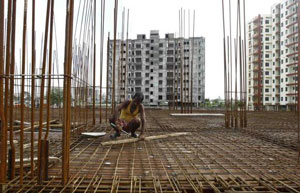
India regains \\\'stable\\\' outlook from S&P on Modi reform agenda
Rafael Nam of Reuters in Mumbai | Monday, 29 September 2014

India regained its "stable" rating from Standard and Poor's on Friday, more than two years after an embarrassing downgrade, in a validation of Prime Minister Narendra Modi's ambitious agenda of economic and fiscal reforms.
S&P had cut India's "BBB-minus" rating to "negative" in April 2012, leaving it on the verge of a "junk" rating. That came to symbolise plummeting investor confidence because of corruption cases and a perception of the political paralysis of the then Congress-led government.
But foreign investor confidence has returned after Modi was elected in May, pledging to revive investments and boost growth. He will travel to the United States later on Friday on his first visit as prime minister, and has meetings lined up with 17 U.S. corporate chiefs.
Shares have surged to record highs this year and bonds have also rallied, in a remarkable comeback from last year, when India suffered its worst market turmoil since a 1991 balance of payment crisis - all based on the promise held by Modi's agenda.
The S&P upgrade is likely to buy Modi some more time to deliver on these sky-high expectations, as the credit agency urged the government to resolve growth impediments such as bottlenecks on energy supply.
"Our outlook revision indicates that we believe the current government's strong mandate will enable it to implement many of its administrative, fiscal and economic reforms," S&P said in its statement.
India is now rated at the lowest investment grade with a "stable" outlook by all three major global credit agencies, in line with fellow BRICS countries Brazil and South Africa.
The government welcomed S&P's upgrade, which had been much speculated upon in markets in recent weeks.
"The stable outlook reflects our view that the new government has both willingness and capacity to implement reforms necessary to restore some of India's lost growth potential," Arvind Mayaram, the country's economic affairs secretary, told reporters after the upgrade.
S&P cited India's external position and its improving current account balance as other positive factors.
India's progress in narrowing its current account deficit, with measures such as curbs on gold imports by the previous Congress government, along with Reserve Bank of India Governor Raghuram Rajan's commitment to curb inflation, were factors behind the recovery of foreign investor interest in India.
But key constraints include India's "low wealth level" as well as its "weak public finances," the credit agency noted. S&P also warned it could lower India's rating should the reform agenda stall over the next 24 months.
Modi's government still faces a key test in meeting its ambitious fiscal deficit target of 4.1 per cent of gross domestic product for the year ending in March, which will need tax revenue to pick up and the successful partial privatisations of state-run companies, such as Coal India (COAL.NS).
The government has also pledged to revive investments and boost infrastructure projects to boost the economy after the last two years marked India's longest spell of growth of less than 5 per cent in a quarter of a century.
But indicators remain mixed, while Modi disappointed investors in July with a budget that unveiled few of the major reforms they had expected.
Analysts said India remained far from an actual ratings upgrade, while market gains could reverse should reforms waver.
"While some quarters will make a case for a rating upgrade next, the latter is still some distance away, as some clarity is still required on the fiscal consolidation efforts, take-off pace of the reform agenda and sustained pick-up in growth in a controlled inflationary environment," said Radhika Rao, an economist for DBS in Singapore.
Still, S&P added it could raise India's rating should it return to an annual real per capita gross domestic product growth of 5.5 per cent, and if fiscal, external and inflation metrics improve.
"The stable outlook for the next 24 months reflects our view that the new government has both the willingness and capacity to implement reforms necessary to restore some of India's lost growth potential, consolidate its fiscal accounts, and permit the Reserve Bank of India to carry out effective monetary policy," it said.